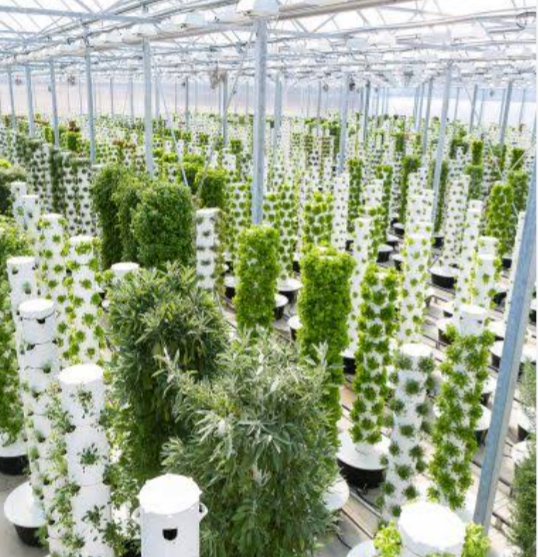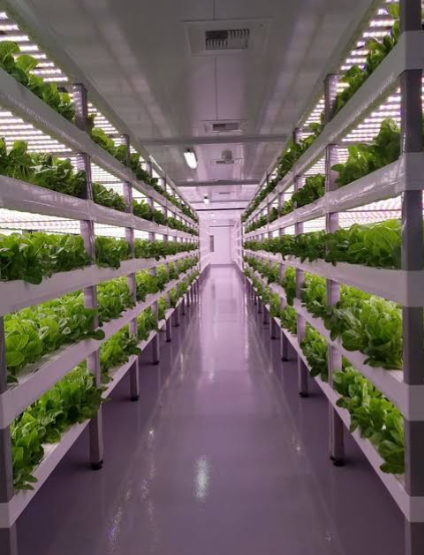
Agriculture had being facing a lot of challenges of late due to continuous increase in human population. The food need of human can no longer be met. Therefore, there is need for increasing the agricultural production level of each country so as to meet the requirement of each individual. To achieve this, a new farming technology called Vertical farming had been developed.
Vertical farming is the practice of growing crops in vertically stacked layers in a controlled-environment. It is also referred to as smart farming. The aims of these farming is to optimize plant growth, and soilless farming techniques such as hydroponics, aquaponics, and aeroponics
The vertical layers are integrated into buildings such as skyscrapers, warehouses or shipping containers, greenhouses, or placed in other types of controlled environment. In the environment, temperature, light, water, and humidity must be control. Energy-efficient LED lights is used as source of light all year-round inorder for the plants to produce their food through photosynthesis. Sunlight is not used. Around each plant, a microclimates is created for their growth and development.
ADVANTAGES OF VERTICAL FARMING
1. INCREASE IN CROP YIELD PER UNIT SMALL AREA OF LAND( OPTIMIZATION OF SPACE USAGE ) It brings about higher crop yield on a smaller unit area of land(that is, per square foot of land used). The multiple layers, maximizes the use of available space. Agricultural challenges, such as providing more food on less land can be achieved sustainably.
2. CULTIVATION OF MULTIPLE CROPS AT THE SAME TIME: Another sought-after advantage is the increased ability to cultivate a larger variety of crops at once because crops do not share the same plots of land while growing.
3. WEATHER EFFECT: crops are resistant to weather disruptions because of their placement indoors, meaning fewer crops are lost to extreme or unexpected weather occurrences. Optimal conditions are provided for crop growth which result in consistent yield and reduced waste production.
4. FEW PEST AND DISEASES EFFECT : farmers utilize treated irrigation water in the indoor environment which are safe from pathogens that can cause diseases on the crops. Also, proper monitoring of the crops are carried out, thereby enabing farmers to control the entire journey of every crop right from when the seeds are planted to harvesting and processing. optimizes space usage.
In addition, vertical farming is less disruptive to the native plants and animals, leading to further conservation of the local flora and fauna.
5. HIGH PRODUCTION LEVEL: farmers are able to produce more output, use fewer resources, and reduce transportation by locating operations closer to the point of consumption.
6. CONSISTENT SUPPLY OF FOOD : vertical farms can grow crops throughout the year. This is because resources used for production such as temperature, light, water, and humidity etc are artificially built within the indoor environment to supply the plants needs. Therefore, no off weather condition that affect horizontal farming occurs in vertical farming.
7. EVERYWHERE FARMING: Indoor farming makes it possible to grow crops In every area, such as in homes, restaurants, harsh environments like deserts, tundras, and even outer space etc. Astronauts can now have assess to fresh food in outer space. People can have access to fresh crop produce without traveling long distance.
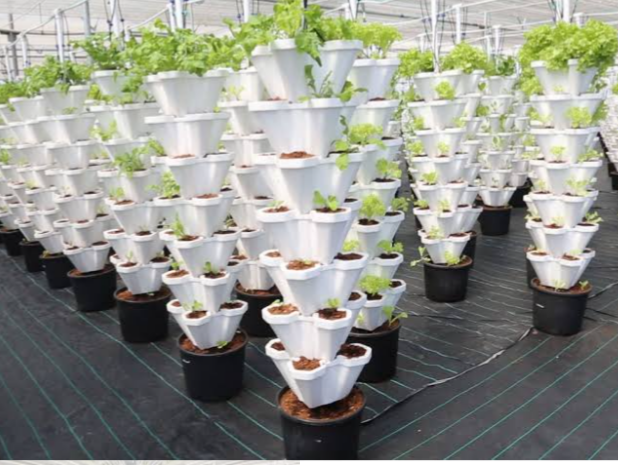
DISADVANTAGES OF VERTICAL FARMING
1. HIGH INVESTMENT COST: The start up cost of Vertical farming technologies is high compared to traditional farming system.
2. HIGH ENERGY USAGE: The energy required in Vertical farming system is large. High energy LED lightening are needed to be Installed in the enclosed building for the plants to be able to photosynthesize. Such lightening also needs a regulatory system to control the lightening intensity for the plants at their different stages of development.
3. DEFICIENT IN RAISING PLANTATION CROPS: Arable crops, most horticultural crops, etc can be raised using vertical farming. But raise of plantation crops till fruiting is not possible. It can be used as nursery to raise plantation crops which will later be transplanted to the field after they outgrow the seedling stage.
4. RESOURCES NEEDED: This system of farming requires different operations, planning and inputs. These increases the production costs of the farming practices. Different resources such as machines, installation of irrigation systems, lightning systems, planting materials, etc are needed to start the system and good management practices must be embacked upon for the success of the project .
METHODS OF GROWING CROPS IN VERTICAL FARMING.
Vertical farms does not use soil. Instead, hydroponics, aeroponics, or even aquaponics can be used to grow plants.
Hydroponics

Hydroponics refers to the technique of growing plants without soil but in nutrient-rich water solutions. The plants’ roots are suspended in the nutrient-rich water solution. The water solution must contain carefully calculated mix of macronutrients, such as nitrogen, phosphorus, potassium, calcium, sulphur, and magnesium, as well as trace elements, including iron, chlorine, manganese, boron, zinc, copper, and molybdenum. In addition, inert mediums such as gravel, sand, or expanded clay aggregate are used as soil substitutes to provide support for the roots.
Aquaponics
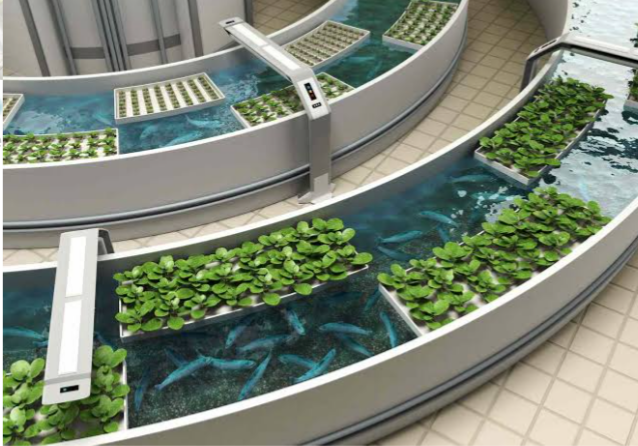
The term aquaponics is coined by combining two words: aquaculture, which refers to fish farming, and hydroponics—the technique of growing plants without soil but rather in nutrient rich solution. Aquaponics integrates the production of terrestrial plants with the production of aquatic organisms in a closed-loop system that mimics nature itself. This brings about a type of symbiotic ecosystem where fish waste provides nutrients for the plants. Nutrient-rich wastewater from the fish tanks containing toxic ammonia is converted to nutritious nitrate. Plants absorb the nitrate and also purifies the wastewater, which is recycled back to the fish tanks. In the same manner, the plants consume carbon dioxide produced by the fish, and water in the fish tanks obtains heat which helps to maintain the temperature of the enclosed building at night to save energy.
Aeroponics

This is a sustainable soil-less growing technique
invention that was initiated by NASA ( National Aeronautical and Space Administration) around the year 1990. The aim was to find an efficient way to grow plants in space . No liquid or solid medium for growing plants is required. Only a liquid solution containing nutrients is dispersed through mist on plants suspended in air. Due to the fact that no growing medium is needed, aeroponic systems is now used in vertical farming to grow diverse numbers of plants. But it is not as popularly used in vertical farming compared to hydroponics and aquaponics.
REQUIREMENTS FOR A SUCCESSFUL VERTICAL FARMING
Vertical farming is carried out in enclosed structures such as greenhouses or buildings, where the environmental factors are under control. Such factors including air, temperature, light, water, humidity, carbon dioxide, and plant nutrition. Some of these factors are briefly discussed below:
WATER SUPPLY :Automated irrigation systems, such as drip irrigation is used to ensure precise and controlled water delivery to your crops. This helps to prevent water wastage, and keep the soil moist so that the plants can grow healthy and produce higher yields.
PHOTOSYNTHESIS : Plants need food through the process of photosynthesis to produce photosyntates required for production. LED lights installed in the building provide energy-efficient lighting solutions. The light spectrum can be adjusted for different plant growth and at different stages.
ENVIRONMENTAL CONDITIONS: The environmental condition of the room must be maintained and controlled. Heating, Ventilation, and Air Conditioning systems are needed in the farm to regulate the room temperature, humidity, and air circulation. They will ensure optimal growing conditions, prevent disease and mold, and maximize crop yields.
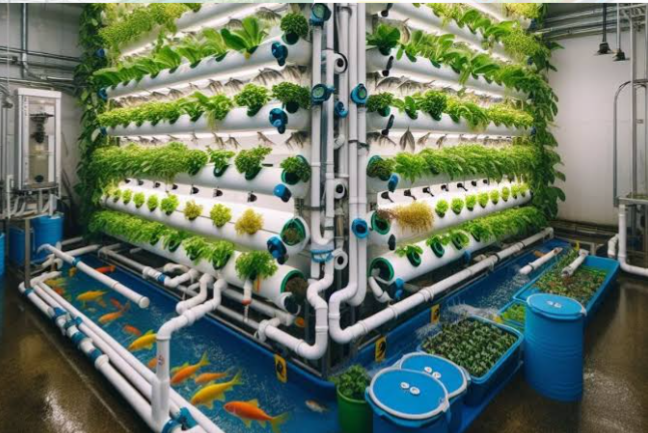
In conclusion, farming systems might experience a drastic turn around to proffer solutions to the problems of food shortage and insecurity in the nearest future. As countries begin to develop new farming technologies such as vertical farming, starvation will become a historical footage among the populace.
